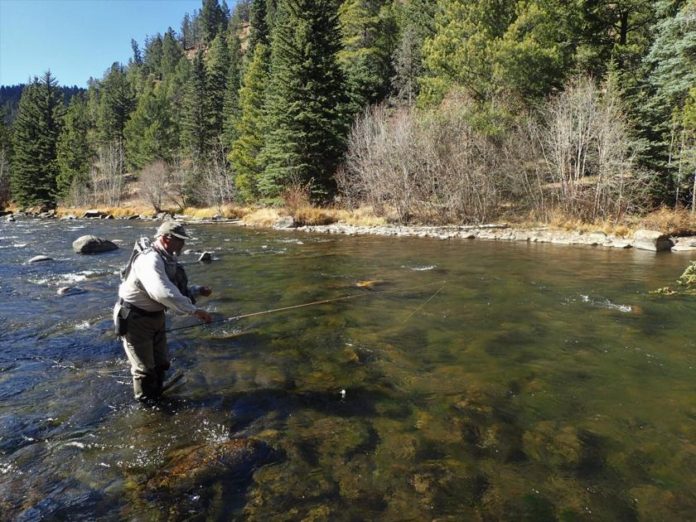Everybody has their favorite kind of water. What’s yours?
Lakes, rivers? Large, small? Big, little? Maybe all — maybe you can’t choose for fear of missing something. I suppose that’s me.
But wow do I like the Taylor. Big enough to have good fish not even counting the tailwater below the dam, yet small enough to wade with late season low flows. A road all along the way with ample pulloffs and public water, but remote enough to not be crowded. Spin fish or fly fish, wet or dry, top or bottom.
Much of the attention, especially for those from out-of-state, is focused on the tailwater fishery below Taylor Reservoir with its reputation for big fish. Fish measured in pounds instead of inches. But there is much more to the Taylor River drainage. Consider this: beginning upstream above the reservoir and working down are the feeder streams such as Texas Creek, Italian Creek, Willow Creek and Taylor Creek, which fill Taylor Reservoir.
Then in turn, more creeks combine below the dam into Taylor River, joined downstream by the major tributary of Spring Creek, together flowing through a winding canyon to the town of Almont. At Almont, the East River comes in from the Crested Butte area to the north, joining with the Taylor River flowing from the east, to form the beginning of the southern-flowing Gunnison River.
The feeder streams to the reservoir are many. Taylor Creek and Willow Creek are paralleled by a road most of the way. The road along Taylor Creek is a good gravel road most of the way, eventually becoming a four-wheel drive road which leads over Taylor Pass to the ghost town of Ashcroft and to Aspen. During the mining days at the turn of the century, this was the main road between Aspen and Crested Butte.
Almost all of Taylor Creek is within the Gunnison National Forest, so public access is excellent. There are several small reservoirs and ponds in the area, as well as campgrounds. The creek is very small in the upper reaches, but has a good supply of water downstream in the vicinity of the Pothole Reservoirs.
Willow Creek is similar but smaller. The road alongside Willow Creek leads to Tincup and Cumberland Pass and Pitkin, and eventually to Highway 50 east of Gunnison. Willow Creek is mixture of private and public land, with a few good stretches of public access near the Taylor Reservoir end. Due to it’s small drainage, only the lower half approaching the reservoir has enough water to be fishable.
Other creeks, such as Texas Creek, require some footwork to get to, but will get you into lonely places. The road from Taylor Reservoir over Cottonwood Pass to Buena Vista never comes very close to Texas Creek, but if you are prepared to hike several miles, there are some trails leading from the road to the creek.
Taylor Reservoir is one of the biggest bodies of water on the Western Slope. The reservoir is primary storage for irrigation water for the Uncompahgre Valley. Taylor Reservoir provides fishing, boating and camping recreation. Recreation here is year-round, as even in winter the road is kept open and ice-fishing and snowmobiling become the sports of choice.
Taylor Reservoir is known for producing large lake trout and pike, as well as rainbow and brown trout of bigger than average size. Fishing is excellent from either shore or boat. Shore fishermen can do well in the spring right after ice-out when the big fish leave the depths and cruise the shallows. Fall fishermen have to bundle up from the cold, but you may be the only one around. A country store with cabins for rent provides a gathering place and jumping off point for all of the recreational users.
Below the reservoir, Taylor Creek becomes Taylor River. I’ve already mentioned the river immediately below the dam, which gets most of the attention because of the abnormally large fish. But the Taylor River is much more. From Taylor Reservoir downstream to Almont, the Taylor River offers some of the best of Colorado — great scenery, nice campgrounds, good fishing and easy access. But be mindful of several long stretches of private land, particularly above Lottis Creek.
But downstream from there, there is good public water. Don’t ignore the river downstream closest to Almont. This is one of my favorite areas. I think most people leave Almont and head immediately upriver, looking for that better water, and consequently the lower river is less fished. But there is public water almost immediately upstream of Almont.
The Taylor River can be difficult to wade, but wading isn’t always necessary. Spin fishing is very productive, and the accurate caster can reach most holes and riffles without needing to wade. Because of the brushy banks, the fly fisherman will want to get in the water, at least into the edges to create a casting lane. For both spin and fly fishers, small hardware and files are the choice offering. You will find mostly brown trout of eight to twelve inches, as well as rainbow or a rare cutthroat.
The Taylor River area is a big drainage offering much besides fishing. Camping, four-wheeling, scenery, hiking, wildflowers, rafting, circle driving tours, river fishing, lake fishing, fish in pounds, fish in inches — it has it all.
Joel L. Evans is an avid fisherman, outdoor writer and photographer who has explored Colorado for decades.
Credit: Source link






























